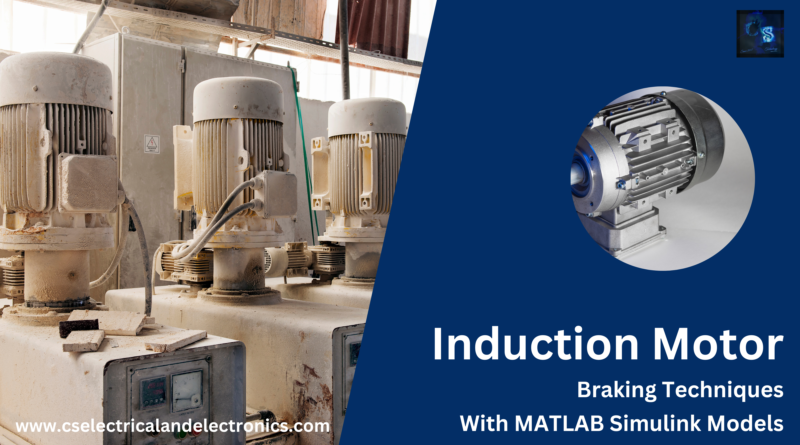Induction Motor Braking Techniques With Simulink Models
Hello guys, welcome back to our blog. Here in this article, we will discuss different types of Induction motor braking techniques with Simulink models, here we will analyze the voltage, current, speed, and toque waveforms of different induction motor braking techniques, and their working.
If you have any electrical, electronics, and computer science doubts, then ask questions. You can also catch me on Instagram – CS Electrical & Electronics.
Also, read the following:
- Different Types Of Testing Instruments Used In Substations
- Top 100+ Python Projects With Source Code, Free For Students
- What Is Onboard Charger, Purpose, Onboard Charger Working
Induction Motor Braking Techniques
An electrical device known as an induction motor transforms electrical energy into mechanical energy. Over 90% of all electric motors in use today are of this type, making it the most prevalent type.
The principles of electromagnetic induction are applied in the operation of induction motors. A stator and a rotor make up the motor. The stator, which is the motor’s stationary component, has a number of wire windings that are powered by AC current. The rotor, which is attached to a shaft, is made up of a number of coils or conductive bars that are organized in a certain pattern.
A revolving magnetic field is produced when the stator receives AC electricity. This magnetic field interacts with the magnetic field of the stator by causing an electrical current to flow through the rotor. The force produced by this engagement propels the rotor into rotation.
The fact that induction motors don’t need a separate power source to generate the rotating magnetic field is one of their key advantages. They are therefore incredibly effective and dependable. They have a long lifespan, are very inexpensive, and are simple to maintain.
Pumps, compressors, fans, conveyors, and machine tools are just a few examples of the many uses for induction motors. They are also frequently found in home appliances including air conditioners, refrigerators, and washing machines.
From small motors used in home appliances to huge motors used in industrial applications, induction motors come in a variety of sizes and power ratings. The two most popular varieties are squirrel cage and wound rotor motors. They are normally categorized based on their architecture.
The most prevalent kind of induction motor is the squirrel cage motor. Its rotor design, which comprises conductive bars joined at both ends by conductive end rings to form a cage-like structure, is the source of its name. Squirrel cage motors have a straightforward design, are inexpensive, and require relatively little upkeep.
On the other hand, wrapped rotor motors have a rotor made of a number of coils coiled around a laminated iron core. These coils are attached to slip rings, which enable the connection of external resistors to the rotor circuit. Applications requiring variable speed control or a strong starting torque call for wound rotor motors.
The two most popular forms of induction motors are single-speed and variable-speed motors. Induction motors can also be categorized according to their speed. Single-speed motors are employed in applications where a constant speed is necessary, like pumps or fans, and operate at a fixed speed.
Contrarily, variable-speed motors allow the speed to be changed to accommodate shifting load demands, which makes them perfect for uses like conveyors or machine tools.
Induction motors, in conclusion, are a flexible and dependable class of electric motors that are widely utilized in a variety of applications. They are a common option for both home and industrial use because they are effective, affordable, and little maintenance.
Braking Of Induction Motor
An induction motor’s braking is the process of slowing it down from its operating speed. It is necessary to regulate the motor’s speed in order to stop it from coasting when the power is turned off or from exceeding its desired speed.
To prevent accidents, lessen equipment wear and tear, and raise system efficiency, it is crucial to stop the motor swiftly and safely in many industrial applications. In situations where the motor must keep a particular position or reverse its direction of rotation, braking is also important.
An induction motor can be stopped using a variety of techniques, such as plugging, dynamic braking, regenerative braking, and DC injection braking. The kind, size, and load characteristics of the motor, as well as the particular needs of the application, all influence the braking method selection.
Induction motor braking is a crucial technique that enables the safe and effective functioning of industrial machinery and equipment.
Induction Motor Braking Techniques
01. Induction Motor Braking Capacitor Based
A way of quickly decelerating an induction motor utilizing a capacitor linked in series with the motor windings is known as a capacitor-based braking system. When the motor is unplugged from the power source, the capacitor is utilized to produce a high-voltage transient in the motor’s windings. This transient is created by the capacitor’s high capacitance, which is normally in the range of 1-2 microfarads.
When the motor is unplugged from the power source, the magnetic field’s stored energy is released through the capacitor, creating a high-voltage transient. This transient voltage is placed across the windings of the motor, causing a current flow that resists spinning and causes the motor to decelerate quickly.
The capacitor-based braking system is an easy and affordable way to quickly slow down an induction motor. It cannot be used for high-power applications since the capacitor has a finite capacity to store energy. Moreover, the system may produce high-voltage transients that could harm the motor’s windings or other system components.
As a result, the choice of braking technique depends on the size of the motor, the load characteristics, and the demands of the particular application. When using a capacitor-based braking system, it’s crucial to make sure that the capacitance is suitable for the motor and the load, and that the system is properly built and installed to guarantee safe and dependable performance.
In low-power applications where the motor does not have a high moment of inertia or a significant mass to be decelerated, capacitor-based braking systems are frequently employed. These systems are frequently utilized in fan and pump applications where it is necessary to swiftly stop the motor in order to protect the machinery or avoid coasting.
The capacitor-based braking system is an appealing alternative for small and medium-sized applications since it is simple to install and affordable. Moreover, it can be added to current systems retroactively without requiring major alterations or upgrades.
The highest deceleration rate that may be accomplished using the capacitor-based braking system is, however, constrained by factors like the quantity of energy that can be stored in the capacitor. By raising the capacitance or by connecting more capacitors in parallel, the deceleration rate can be increased.
The capacitor-based braking system’s ability to generate high-voltage transients that could harm the motor’s windings or other system components is another drawback. Surge protectors and other devices that reduce voltage transients can help to mitigate this.
Overall, capacitor-based braking systems are an easy and affordable way to quickly slow down low-power induction motors. However, other braking techniques, including dynamic braking or regenerative braking, might be more appropriate for high-power applications.
02. Induction Motor Braking DC Dynamic Based
An induction motor can be stopped using DC dynamic braking by disconnecting the power source and delivering a DC voltage to the motor’s windings. This voltage produces a magnetic field that resists the motor’s rotation, slowing it down until it finally stops.
In applications like elevators, cranes, and trains where the motor has a high moment of inertia or a significant mass, DC dynamic braking is frequently used. To avoid accidents or equipment damage in these situations, it’s crucial to rapidly and safely bring the motor to a stop.
Typically, a DC power source or a rectifier that changes the AC voltage from the motor’s windings into DC voltage provides the DC voltage needed for dynamic braking. The motor’s windings are then exposed to the DC voltage through a switch or relay.
One benefit of DC dynamic braking is that it can quickly and completely halt the motor while also offering high deceleration rates. It can also be utilized to regulate the motor’s speed while decelerating.
DC dynamic braking does have some restrictions, though. If the braking process is not properly controlled, the DC voltage might build heat in the motor’s windings, which can harm the motor or shorten its lifespan. Moreover, the DC voltage may introduce electrical noise or interference into the system, which may have an impact on nearby devices or components.
Overall, DC dynamic braking is a useful technique for stopping induction motors in applications involving large mass or inertia. To ensure secure and dependable operation, it needs careful design and management.
03. Induction Motor Diode Braking Based
An easy and economical way to stop an induction motor is with a diode. To create a low impedance path for the back EMF produced when the motor is unplugged from the power source, a diode is used and linked in series with the motor’s windings. The magnetic field produced by the back EMF resists the spinning of the motor and causes it to decelerate quickly. This back EMF produces a current that runs between the diode and the motor’s windings.
The braking circuit’s diode must be capable of handling the maximum current and voltage that the motor can produce during braking. Usually, the circuit uses a high-power diode, such as a fast-recovery diode.
Diode braking has the advantages of simplicity and affordability. Small and medium-sized applications where the motor has a low moment of inertia or a low mass can readily apply it. Also, it effectively stops the motor abruptly and stops it from coasting.
Diode braking does have some restrictions, though. The motor’s back EMF, which is often lower than that of other braking techniques like dynamic or regenerative braking, limits the deceleration rate. However, if the braking process is not correctly managed, diode braking might damage the motor or shorten its lifespan by creating heat in the motor’s windings.
Overall, the use of diode brakes to stop induction motors in low-power applications is straightforward and efficient. However, other braking techniques, such as dynamic or regenerative braking, may be more appropriate for high-power applications. The size of the motor, the load characteristics, and the requirements unique to the application all influence the braking method selection.
The ability of diode braking to produce high-voltage transients when the diode is turned off is another drawback. The windings of the motor or other system components may be harmed as a result. The voltage transients can be reduced and the motor can be protected by adding a snubber circuit to the diode braking circuit.
Diode braking shouldn’t be used continuously or for an extended period of time because it can overheat the motor and harm it. It works well for sudden stops or short-term braking.
In applications where the motor has a low moment of inertia or a tiny mass, including fans, pumps, and small machine tools, diode braking is frequently employed. In battery-powered automobiles, where regenerative braking is neither feasible nor practicable, it is also used.
In conclusion, diode braking provides a straightforward and economical technique for stopping induction motors in low-power applications. It works well at abruptly cutting off the motor and keeping it from coasting. The pace of deceleration, heat generation, and voltage transients are its limitations, though. It works best for quick stops or emergencies; for high-power applications, alternative braking techniques should be taken into account.
04. Induction Motor Braking Plugging Based
Induction motors can be stopped by plugging by rotating them in the opposite direction. This is accomplished by switching the supply voltage’s polarity to the motor’s windings, which causes the magnetic field to flip and the motor to halt abruptly.
In applications like conveyor belts or cranes where the motor is employed for irregular or cyclical actions, plugging is most frequently used. To avoid accidents or equipment damage in these situations, it’s crucial to rapidly and safely bring the motor to a stop.
The motor must first be unplugged from the power source before the supply voltage may be switched by switching the motor’s terminals. As a result, the motor starts to function as a generator and generates a reverse torque that slows the motor down and causes it to halt.
One benefit of plugging is that it can enable rapid deceleration rates and quickly bring the motor to a stop. It can also be utilized to regulate the motor’s speed while stopping.
The protection of the motor and the driven load is a crucial factor to take into account while employing plugging. If the braking process is not adequately regulated, plugging can result in mechanical strains on both the motor and the load, which may cause damage or failure. It is crucial to employ a soft-start circuit to progressively lower the motor’s speed before implementing the plugging operation in order to mitigate this. This increases the system’s safety and dependability by lowering the mechanical stress on the load and the motor.
Another drawback of plugging is that it can result in significant inrush currents when the engine is started up again after braking. The windings of the motor or other system components may be harmed as a result.
This can be reduced by adding a current-limiting component to the circuit, such as a resistor or a reactor, which will reduce the inrush current and safeguard the motor.
Because it takes time for the braking process to reverse the direction of the motor’s spin, plugging is not appropriate for applications where the motor needs to be stopped rapidly and then restarted right away. Other braking techniques, such as dynamic or regenerative braking, may be more appropriate for these purposes.
In conclusion, plugging is a useful technique for stopping induction motors in intermittent or cyclic applications. It is capable of delivering rapid deceleration rates and quickly stopping the motor. Other braking techniques should be taken into consideration for continuous or high-power applications since it demands careful design and control to assure safe and reliable operation.
Which Is The Best Induction Motor Braking Technique
The application-specific criteria determine the optimal induction motor braking method. The best braking method will depend on a number of variables, including the type and size of the motor, the characteristics of the load, the desired braking torque and deceleration rate, and the required braking time. Each braking technique, including DC dynamic braking, capacitor braking, plugging, regenerative braking, and others, has its own advantages and limitations.
Regenerative braking is one extremely effective method that may recover energy, lower power consumption, and is appropriate for high-power applications where energy efficiency is crucial. On the other hand, plugging is a quick and easy technique for stopping a motor in intermittent or cyclic applications.
Generally speaking, a variety of braking methods may be utilized in combination to offer optimal performance and efficiency for a particular application. For high-power applications, for instance, a combination of regenerative and dynamic brakes can provide efficient and effective braking, whereas capacitor or plugging braking may be more appropriate for low-power applications.
When choosing the best braking method for a given application, it’s crucial to consult with a skilled engineer or technician who can take into account all the relevant variables.
This was about “Induction Motor Braking Techniques“. I hope this article may help you all a lot. Thanks for reading.
Also, read:
- 10 Tips To Maintain Battery For Long Life, Battery Maintainance
- 10 Tips To Save Electricity Bills, Save Money By Saving Electricity
- 100 (AI) Artificial Intelligence Applications In The Automotive Industry
- 100 + Electrical Engineering Projects For Students, Engineers
- 1000+ Control System Quiz, Top MCQ On Control System
- 1000+ Electrical Machines Quiz, Top MCQs On Electrical Machines
- 1000+ MATLAB Simulink Projects For MTech, Engineering Students
- 50 Tips To Save Electricity At Home, Shop, Industry, Office
Author Profile
- Chetu
- Interest's ~ Engineering | Entrepreneurship | Politics | History | Travelling | Content Writing | Technology | Cooking
Latest entries
 All PostsApril 13, 2024What Is TCM, Transmission Control Module, Working, Purpose,
All PostsApril 13, 2024What Is TCM, Transmission Control Module, Working, Purpose, All PostsApril 12, 2024Top 100 HiL hardware in loop Interview Questions With Answers For Engineers
All PostsApril 12, 2024Top 100 HiL hardware in loop Interview Questions With Answers For Engineers All PostsMarch 22, 2024Driver Monitoring Systems In Vehicles, Working, Driver Sleepy Alert
All PostsMarch 22, 2024Driver Monitoring Systems In Vehicles, Working, Driver Sleepy Alert All PostsMarch 10, 2024Top 100 Automotive Interview Questions With Answers For Engineers
All PostsMarch 10, 2024Top 100 Automotive Interview Questions With Answers For Engineers








